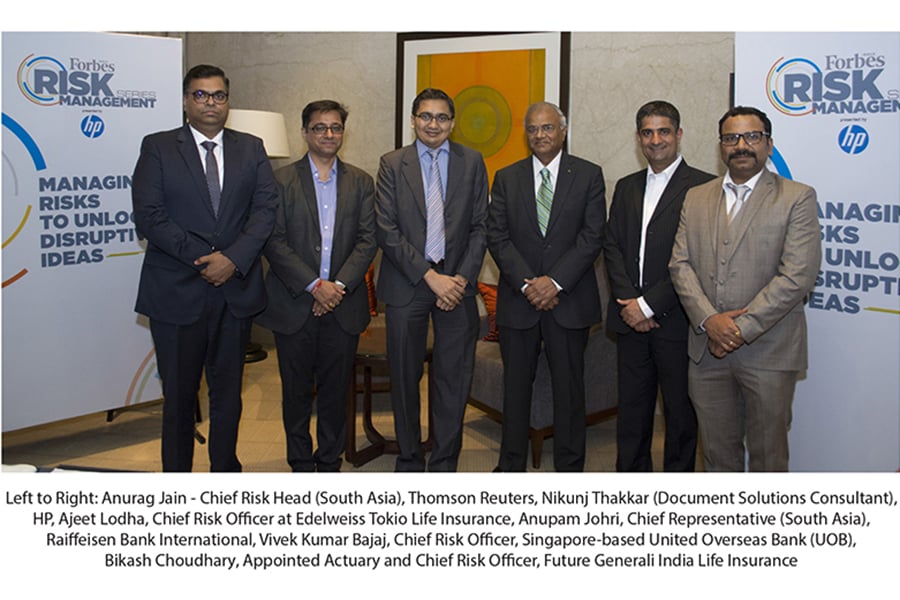Compliance is the biggest risk in healthcare
The healthcare and pharmaceutical industry deals with perhaps the most precious asset in the world: human life. The risks it faces are consequently more sensitive than some other sectors



Risk is an inherent part of the pharmaceutical and healthcare business, as these allied industries continues to take on old and ever-evolving threats. In the quest to effectively deal with increased operational complexities and market fluctuations, these companies are drawing up extensive risk mitigation strategies. To discuss the risks facing these companies, how they impact business and the best practices to counter potential threats to business continuity, senior leaders from India’s pharma and healthcare industries came together for a discussion as part of the Forbes India Risk Management Series, held in Mumbai in association with HP. These leaders included Ranjana Pathak, global head – quality, Cipla Jayant Dwivedy, chief operating officer, USV Ashish Vohra, head of ethics and compliance, South Asia, GSK Joy Chakraborty, chief operating officer, PD Hinduja Hospital Nimish Thakkar, chairman and managing director, Zuvius Life Sciences Vernon de Sa, director – medical affairs, clinical compliance and governance at Saifee Hospital and Kalpesh Jani, senior security advisor at HP.
Panelists were unanimous that for the pharma and healthcare sectors, the biggest challenge is that of compliance, adherence to procedures, meeting the expectations of regulators such as the state health department (for hospitals) and the US Food and Drug Administration (USFDA) for pharma companies exporting to the US.
Of late, many Indian pharma companies have been impacted by regulatory action that have called their manufacturing standards in India to question. According to Dwivedy, the reasons for such moves on the part of the USFDA were due to a change in mindset towards the way reviews are conducted by the regulator.
Around 40-50 percent of generic drugs supplied to the US come from India at present, says Pathak. Previously, since the volume of drugs supplied from India wasn’t so high, the regulator didn’t look at the domestic manufacturing sector as intently before. But after a few highly publicised incidents of Indian pharma companies having concealed information from the regulators and investors came to light, the scrutiny was stepped up.
“The biggest challenge is that of compliance, adherence to procedures, meeting the expectations of regulators such as the state health department (for hospitals) and the US Food and Drug Administration (USFDA) for pharma companies exporting to the US”
In the case of hospitals, which discharge the sensitive responsibility of caring for human lives, the biggest challenge comes in the face of patients and relatives questioning the appropriate cost of treatment, as well as adhering to government mandates of treating a certain quantum of patients from economically weaker sections at a subsidised cost. “This poses a huge financial burden on hospitals,” says de Sa. Chakraborty added that often it was difficult for the hospitals to ascertain whether a certain beneficiary of subsidised treatment was bonafide or not.
“In the past six to eight months, Indian healthcare has been questioned and has encountered huge challenges of the kind not seen for the past 20 years,” Chakraborty said. “People are questioning treatment costs and clinical ethics. Consequently, there is a need for hospitals to adapt to the new environment and deal with these challenges.”
Chakraborty elaborated that the Hinduja Hospital has taken a conscious call of not compromising on its bed charges to attract more patients and this has allowed them to sustain without earning high margins on medical equipment and drugs needed for treatment.
Pharma companies catering to the Indian market have also come under the ambit of Drug Price Control Orders issued by the government to keep the prices of essential medicines in check and make it affordable for the common man. Vohra of GSK feels that while the intent of the government is fair, slashing drug prices isn’t the only way to ensure healthcare inclusion. “You need to create access to medicines at realistic prices for patients and that can be done by partnering with industry and creating avenues such as social better coverage of medical insurance,” he said.
What if there is an adverse observation regarding any particular pharmaceutical company and the US FDA raises a red flag? If doctors do get any information about the quality of the drug or side effects pertaining to that particular drug, they always do a check of the company, the antecedents and then inform the FDA, following which the company can be blacklisted.
While compliance – of processes and data – is definitely a big area for concern for pharma and healthcare companies, they are also acutely conscious that such compliance comes at a cost. While there are technology solutions to help these organisations adhere to the prescribed norms, it costs a lot of money. But most companies are willing to incur all necessary expenditure to remain on the right path, without risking reputational damage. “On quality, we don’t have any compromises. A single complaint can hit our business badly for three-four years,” says Thakkar of Zuvius Life Sciences. “We may cut back on marketing and promotional expenditure if required, but never on budgets to ensure quality.”
In a world where businesses are going increasingly digital, a serious challenge facing companies across the board is also that of cybersecurity – protecting the integrity of data and a company’s intellectual property. Jani of HP was of the view that the assistance of an expert technology companies needs to be solicited to implemented robust data protection mechanisms at organisation. “Even something like a printer, which is used to print our sensitive information and is connected to a larger IT network is susceptible to getting hacked and can be a source of data leak. But this can be avoided with timely intervention,” Jani said.
First Published: Jun 07, 2018, 18:09
Subscribe Now